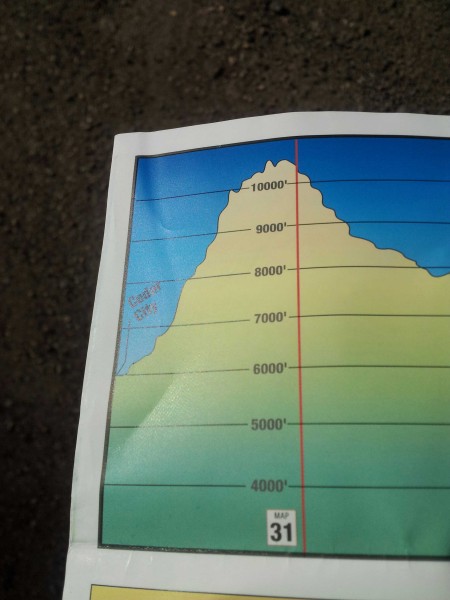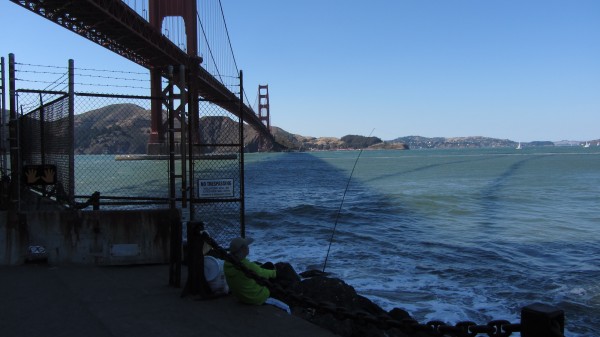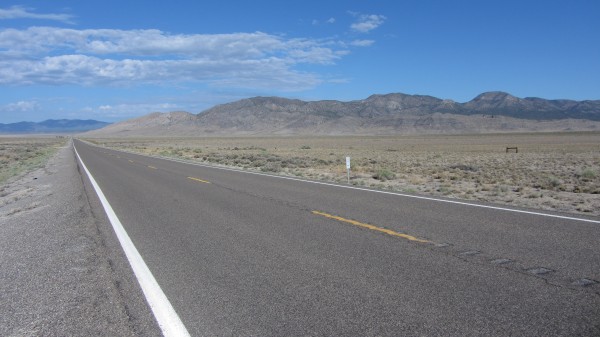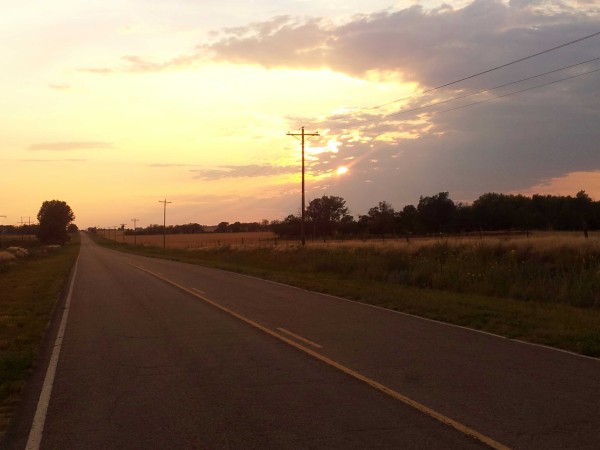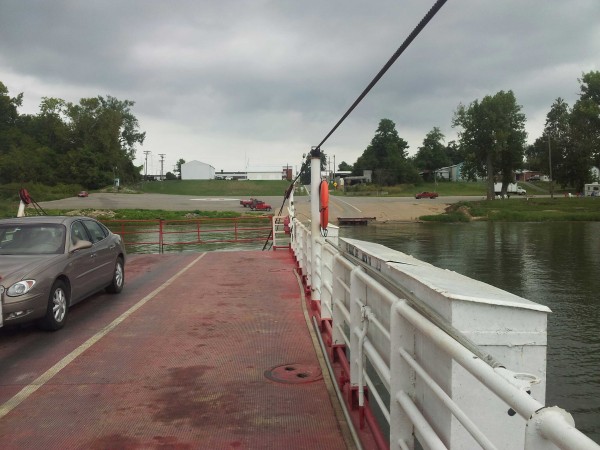This is part three of a series of posts discussing various aspects of a bike trip I did across the United States in 2012. Part one discussed the start of the trip and choosing a route. Part two discussed my daily routine and nightly shelter. This post discusses mileage, elevation, and the state-by-state scenery.
Mileage and elevation change
Excluding the first day, my daily mileage ranged from a low of 57.63mi to a high of 161.47mi. For the first “half” (psychologically) of the trip til Pueblo, I aimed to not lose ground from my overall target pace but didn’t sweat falling slightly short, and I averaged slightly under 100mi/day (even including that farce of a first day). Nevada’s emptiness strongly regimented my stops and pace. At one point I faced three ~70mi stretches between water, with further logistical challenges beyond: given my time constraints, I had to do two in a 135mi day, then the last plus a bit more the next day. But normally I biked shorter distances til the TransAmerica.
The end of the Western Express in Pueblo marked the start of the Great Plains, where I began to make up lost mileage. In Kansas I discovered 120-130mi was my maximum sustainable pace if I didn’t adjust my schedule to start earlier. Any further and the next day would be an invariably “short” 90-100mi. 120mi let me start somewhat later in the morning (I am absolutely not a morning person), eat reasonable lunches and dinners (if sometimes as gas station takeout), and read awhile before a decent night’s sleep. With more focus I might have started earlier and biked further. But I was on vacation, and I was, er, relaxing. If strict discipline wasn’t necessary, I wouldn’t force it.
That said, 120mi wasn’t always possible. The Missouri section had no difficult elevation, but it did have the Ozarks with an unrelenting sawtooth profile: not enough to exhaust, but enough to slow down the entire day. I eventually gave up on playing mileage catchup til Illinois and settled for not losing ground with ~100mi days.
East of the Mississippi had arguably more difficult elevation than west. (Carson Pass might be an exception, as a very long ascent so close to the start.) Virginia’s section has more total elevation gain than any other state’s section. Eastern ascents were shorter but much steeper: nothing that couldn’t be handled shifting to lowest gear and spinning, but more exhausting. The steepest lengthy climb was around 4mi/2500ft to the Blue Ridge Parkway in Virginia. In contrast the climb to the Continental Divide was 10.5mi/2800ft.
Scenery and attractions
California was the least interesting of the western states. The first hundred miles from San Francisco were mostly flat and unvarying: not bad at the start, but still not interesting. The gradual multi-day climb to Carson Pass had its attractions, particularly along California’s SR 88. But California was a short and mostly undistinguished state to bike through, at least along this route.
Of the western states, Nevada was the most majestically desolate. Pass through a basin (carefully winding between mountains), climb to a pass, descend to a basin, and repeat through the entire state. All around were mountains and emptiness; it was the state where I felt most truly alone. (Which as an introvert I consider not a bad thing.) The climbs were never particularly steep, and the descents never astonishingly so, yet I hit ~40mph most days through it. Strangely, of all the states I passed through, I think Nevada is the one I’d most want to return to on bike, even tho it has “nothing” to recommend it.
Utah and the mountainous portions of Colorado were much more varied: good in their own ways, yet not in Nevada’s unique way. After that initial 84mi waterless stretch (from just in Nevada to well into Utah), I encountered irrigated farmland, red sandstone rock formations, and a good variety of desert vegetation. The empty stretches didn’t have the consistency of terrain that Nevada’s did. I did pass through emptiness, but that emptiness carved across mountainsides, descended into and out of valleys, and passed through several national parks with incredible scenery. Nevada’s uniqueness aside, Utah and Colorado were the best states of the trip.
West of Pueblo turned into the Great Plains: the tail end of Colorado, and Kansas. The riding is basically flat, with mercurially-shifting prairie winds kicking in to keep things interesting. Even crosswinds that aren’t actually impeding you can really sap energy. The Colorado portion wasn’t particularly different from the Kansas portion, except that the local towns along CO-96 banded together to create the Prairie Horizons Trail — a naming and sprucing up of the stretch to particularly accommodate touring cyclists, complete with map listing services at locations along the way. It was definitely a nice touch. 🙂 Kansas was much the same, excepting that the route traveled many different roads, slowly cutting south as it crossed the state. Both routes were notable for their sheer emptiness: not in the desolate manner of Nevada, but in the way that, leaving one town, you could see the grain elevator in the next town, and the utter lack of anything but fields of grain before it.
Missouri was my least favorite state for two reasons. I’ve already mentioned its sawtooth climbs and descents. The second reason is that Missouri was one of only two states where I was ever aggressively chased by dogs. This was not a rare occurrence: it happened multiple times, including a couple times in complete darkness. Fortunately, I was able to bike just fast enough that dogs that appeared to have every intention of attacking me could only just keep pace with me til I left their home ranges. I evaded them all, but always with a fast-pounding heart afterward. Missouri did have Al’s Place, the nicest hostel of the entire trip — a former (converted) jail run as a hostel for cross-country cyclists.
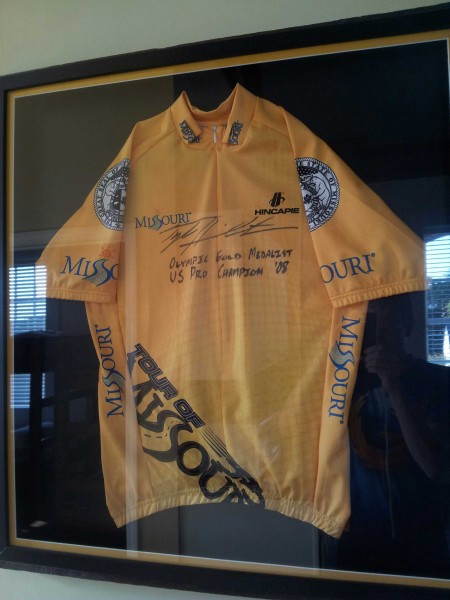
Illinois was a short and sweet state I passed through in about a day, near the southern tip. It had the Mississippi and Ohio rivers at start and end to recommend it, but it was mostly uneventful. It played host to the worst rainstorm of the trip, which passed over me during a brief gas station stop. I delayed leaving an extra fifteen minutes to avoid biking in briefly-torrential rain; it would have been impossible to see through it while riding. Its other attraction was the milk shake at Rose Kountry Kitchen in Cave-In-Rock. I ordered it sight unseen before looking at a menu. When I looked at the menu I discovered there were two sizes; I quickly upgraded my request to the 32-ounce (!) size, to much astonishment from the restaurant staff. There’s nothing better than that many calories, as ice cream, while biking.
Kentucky, sad to say, was at times the grungiest state of the trip. The graffiti on the state welcome sign just past the Ohio didn’t bode well. And the many run-down homes and trailer homes on the many back roads on which I traveled only confirmed this. And Kentucky’s dogs were probably the worst of the entire trip. TransAm cyclists told me of other cyclists who’d had to get stitches from dog bites suffered in Kentucky. I evaded any bites, but as in Missouri, it was very stressful doing so. The best part of Kentucky, however, was the Utica Fire Department, which lets cyclists stay in the volunteer fire station overnight; I particularly appreciated it after a ~142mi day. I just wish I’d been able to say hi to more firefighters while I was there.
Virginia presented the Appalachians, the Atlantic, and the end of the trip. Virginia’s route paralleled the Appalachian Trail for awhile, giving me the opportunity to briefly revisit many places I’d visited four years before. I stopped early in Damascus, partly from tiredness, partly to stay at The Place, a hostel I’d visited while hiking the A.T., partly for a good dinner, and partly to make an early start on the mother of all days the next day. (More on that later.) My mileage worked out just right so that my last day was a pleasurable hundred miles into Yorktown — made slightly hectic by two broken rear spokes with 25mi remaining, yet leaving me several hours in the evening for a good dinner, ice cream, and a beer. Grace Episcopal Church hosted me as a cyclist on this last night, giving me an opportunity to wash laundry and clean myself up before heading to Norfolk to fly back to California the next day. (Yes, this cut it close, but I was fairly sure it was always going to be that way.)
Next time, mileage extremes and water.
